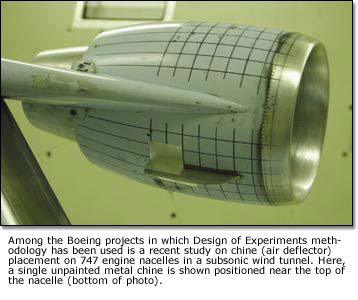| Improving the improving
process
 What
do testing rocket engines,
replacing hazardous chemicals
in electronics fabrication,
and determining passenger interest in
faster airplanes have in common? All
are examples of work that has benefited
from a testing methodology called
Design of Experiments that is much
more efficient and reliable than traditional
one-at-a-time testing. What
do testing rocket engines,
replacing hazardous chemicals
in electronics fabrication,
and determining passenger interest in
faster airplanes have in common? All
are examples of work that has benefited
from a testing methodology called
Design of Experiments that is much
more efficient and reliable than traditional
one-at-a-time testing.
The methodology, based on mathematical
principles and involving the
scientific process, is helping employees
throughout Boeing make better decisions
and improve products and processes
in less time and with less money
and waste.
DOE certainly isn't new. Sir Ronald
Fisher, an English statistician, was the
first to consider a methodology for it
more than 80 years ago. He described
how to structure tests and analyze data
to obtain more reliable conclusions in
the noisy and poorly controlled testing
environment of agricultural research.
Over the years, Fisher's concepts caught
on as a more efficient way to help
improve everything from growing corn
to operating chemical processes and
building cars.
Employees in the Applied
Statistics group in the Phantom
Works Mathematics and Computing
Technology organization have taken the
basic DOE concepts, integrated them
with the latest thinking in mathematics
and computing, and combined them with
a working knowledge of problems and
issues specific to aerospace. The result is
a very efficient methodology for designing
experiments and analyzing data at
Boeing, regardless of whether the work is in design, fabrication, assembly,
testing
or administrative environments.
During the past several years, the
group has applied DOE in many ways
throughout Boeing. Applications have
involved alternative component design
evaluation for military programs, composite
repair in commercial airplanes,
RS-68 rocket engine testing, wind
tunnel testing, and computer hardware
and software design and testing. Other applications have involved market
research for new programs including
the 7E7, ergonomic and health studies,
and evaluation of training methods and
Web interfaces such as the Employee
Timekeeping System. The group also
has used DOE with computer simulations
in many applications, including
aerodynamic and structural design.
Roberto Altschul, manager of the
Applied Statistics group, and Stephen
Jones, a senior DOE statistician, believe
the increased use of DOE within the
company is fundamental to reducing
the cost of testing while improving the
quality of decisions.
“We're here to help apply DOE
techniques to processes, testing, and
decision making throughout Boeing,”
Altschul said.
How it works
In one of many successful examples of Design of Experiments
implementation, when the Commercial Airplanes New Product
Development team was working to improve 747 lift characteristics
during takeoffs and landings, they wanted to do a study to determine
the best placement of chines, or vortex control devices, on the
engine nacelles (streamlined enclosures that house the engines).
But the study needed to be cost-effective. The number of possible
test combinations was enormous. For example, should chines be
used at all? If so, should they be used on one nacelle or two?
Should
they be placed on one side of the nacelle or both? At what angle
should they be placed? How far fore or aft should they be placed?
To try to evaluate all of the combinations in a wind tunnel would
have been too costly and would have taken too much time
to meet program requirements. Instead, Boeing called on the
Design of Experiments team. Using DOE techniques, the team
devised an experiment that not only cost a small fraction of what
traditional methods would have cost, but also provided more informative
insight. Using limited wind tunnel testing, the new research
model provided estimates of lift for all chine combinations (including
those not tested), and identified the best options for placement
of the chines. Boeing proprietary interests preclude divulging further
specifics on chine placement and resulting lift characteristics.
ON THE WEB: Employees can find more details on the Boeing
Web at www.rt.cs.boeing.com/MEA/stat/doe/doe.html
|
|